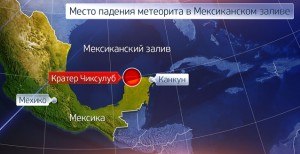 1
1

Arkaim and the texts of Rgveda about his builders
 25. 04. 2024
25. 04. 2024



 1
1
 24. 02. 2024
24. 02. 2024

A deep borehole should be drilled in the Gulf of Mexico into the bottom of the Chicxulub Crater. A meteorite, which is believed to have caused the extinction of the dinosaurs, fell into this place.
The fall of the Chicxulub meteorite has affected life on Earth more than the strongest volcanic eruptions we know today. The planet shook with a devastating blow. The force of the strike was a million times greater than the force of the explosion of a nuclear bomb in Hiroshima.
Tons of dust, stone fragments and soot covered the sky for a long time, obscuring the sun. The shock wave traversed the planet several times, causing a series of earthquakes, volcanic eruptions and tsunamis. The state, similar to a nuclear winter, lasted several years, acid rain fell. This catastrophe marked the end of the dinosaur era.
The recent crater after the Chicxulub meteor was discovered accidentally in 1978, in exploratory boreholes that had found oil on the bottom of the Gulf of Mexico. The longest 70 was found on the submarine moat first  miles, then discovered its continuation on the mainland, in the northwest of the Yucatan Peninsula.
miles, then discovered its continuation on the mainland, in the northwest of the Yucatan Peninsula.
The diameter of the crater is 180 kilometers. Scientists have discovered a gravitational anomaly in this area, then geologists have discovered impact quartz with a compressed molecular structure and glassy tektites that form only at extreme temperatures and pressures.
Now, scientists would like to explore the very bottom of the crater. Drilling from the oil rig is scheduled to begin on April 1, then they are about to drill a 500-meter layer of limestone that has settled to the bottom after the meteorite fell. And then comes the survey of the roughly a kilometer layer and the collection of data on various types of fossils.
But scientists hope to find the most interesting thing at the bottom of the crater, at a depth of about 1,5 kilometers. The simplest microorganisms can live in the cracks of volcanic rocks. If the hypothesis is correct, scientists can find out how life was restored after the catastrophe in its epicenter.